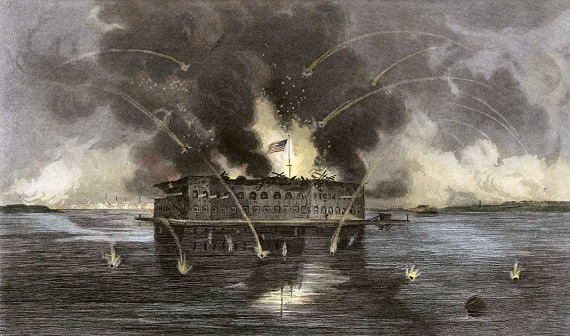There is an old saying in the theater that when one is acting the part of a butler in a play, the actor tends to regard it as a play about butlers. This manner of observing personages and events, both past and present is, of course, a sad fact of life within many levels of modern society. All too often, people today are inclined to view such things through a lens which shows them not as they actually are or were, but rather as the observer might wish them to be or have been. A prime example of this revisionist view is the current controversy over what the South actually represents today and what part it played in the shaping of America’s past.
A case in point for this distorted view of America’s past and present would be on the part of those who now choose to play the role of slavery’s victim. This can be clearly observed in an article which appeared recently in the Los Angeles Times by Jamil Smith, a black freelance journalist who had once served as an editor for the liberal New Republic. In his piece, “Doomed to Fight the Civil War Again,” Smith contends that people who defend any vestige the Confederacy today are guilty of upholding traitors. His argument is based on a White House press conference at which Press Secretary Sarah Sanders defended some remarks made by White House Chief of Staff General John Kelly about honoring the memory of Robert E. Lee and the events that actually brought about the War Between the States. However, in Smith’s opinion, all Kelly was doing was merely defending a slaveholder, as well as displaying his total ignorance of what should be properly deemed as the only true cause of the War . . . slavery.
The writer then went on to infer that in the Nineteenth Century, Southerners alone held the view that Whites were superior to Blacks by citing an excerpt from an 1861 speech by Vice President Alexander Stephens in which he stated in part that “. . . the negro is not equal to the white man . . .” What Smith failed to mention was that such an opinion was almost universally held at that time by those in both the North and the South, including Abraham Lincoln. Even though slavery itself had been ended in the North during the first half of that century, virtually none of the free Blacks who resided within those states were allowed to vote, serve on a jury, testify against a white person or hold any public office, and in some areas, such as Lincoln’s Illinois, they even barred free Blacks from settling within the state. As to Lincoln himself, while he publicly disapproved of the institution of slavery, he was never an abolitionist and favored the idea of shipping Southern slaves, once they were freed, back to Africa, a land that the vast majority of American slaves had never known. On many occasions during his life, Lincoln also voiced the opinion that Blacks would never be the social or political equal of Whites. Moreover, most white people throughout the North in those days rationalized their feeling of racial superiority by citing all manner of contemporary biological, religious and social theories . . . basically the same type of theories created by the Nazis a century later in their effort to prove Aryan superiority over other races.
Smith’s column also challenged General Kelly’s contention that one of the basic causes of North-South friction during the antebellum period was a lack of compromise on the part of both sides. In Smith’s piece, he wrote that there had already been far too many compromises made in favor of the South, and cited the “Three-Fifths Compromise” and “Kansas-Nebraska Act” as examples. He also attempted to support this opinion by citing two like-minded black writers, Ta-Nehisi Coates, an author and comic book writer from Baltimore, and Jalani Cobb who writes articles for the New Yorker magazine. Had Smith bothered to take the time to read even a little American history by any of the more than a hundred actual scholars who have produced numerous works on the North-South struggle in the periods prior to, during and following the War Between the States, he would have found that the “Three-Fifths Compromise” proposed in 1787 by two Northerners, Roger Sherman of Connecticut and James Wilson of Pennsylvania, basically involved whether or not slaves were to even be considered as people. During the Constitutional Convention of that year, there were, of course, vested political motivations behind the effort of the Northern delegates to exclude all slaves from any national population enumeration, and that of the South to include all slaves in such a census. In essence, however, the Northern position basically contended that slaves did not actually exist as people, while the South argued that they did.
Furthermore, a bit of additional study into antebellum history would have revealed to Smith that the “Kansas-Nebraska Act ” was not really a “compromise” per se, but a measure offered by Senator Stephen Douglas of Illinois in 1854 to fairly allow popular sovereignty to decide the issue of slavery’s legality in those two new states. The Act did, however, redraw the boundaries of slavery that had been established in the “Missouri Compromise of 1820,” legislation which also allowed Maine to be admitted to the Union as a free state, and Missouri as a slave state.
Smith further drew the questionable conclusion that anyone who honors Southern history and heritage via the figure of someone such as General Lee, a person he categorized as “a white man who betrayed America to enhance the unearned franchise of whiteness,” is viewing both the Confederacy and the War through the lens of the white slaveholders . . . rather than the proper one of the black slaves. Like many others, Smith then used his piece as a platform from which to submit the racial arguments that many in America still regard Blacks as less than human and that organized racism is still rampant in the country, as well as that justice is not yet color blind and all levels of American government are controlled by white men who who sit in judgement of the “disempowered” minorities.
For the grand finale of the article, the readers were then returned to the same White House press conference, with Smith charging that a “serious question” asked by April Ryan of the American Urban Radio Network, a subsidiary of the National Black Network, was left unanswered by the press secretary. The loaded racial question posed by Ryan was . . . “Does this president believe that slavery was wrong?” Sarah Sanders properly replied that is was “disgusting and absurd” to even suggest that anyone in the White House supported slavery. Smith, however, took her reply to infer that since she did not give a definite yes or no answer, it still remained a “moot question” as to whether or not the president or General Kelly were in favor of slavery. He also went so far as to charge that even if they were not, both men still “support the slavers.” It should, therefore, be quite obvious that there can be no hope whatsoever of altering or even reaching any form of compromise with such blatantly biased and racially charged thinking.
Sadly, however, on today’s socio-political stage, the major media has assumed the butler’s role of serving up to the American public a constant course of such slanted fare. If anyone, even a White House chief of staff and Marine Corps general, dares to disagree with any dish in this never-ending diet of attacks on Southern history, heritage or its traditional way of life, they are, as seen in Smith’s column, immediately pilloried by the media, and seldom given little if any opportunity to question the media’s menu.







